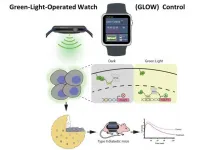High caffeine consumption may be associated with increased risk of blinding eye disease
2021-06-07
(Press-News.org) Consuming large amounts of daily caffeine may increase the risk of glaucoma more than three-fold for those with a genetic predisposition to higher eye pressure according to an international, multi-center study. The research led by the Icahn School of Medicine at Mount Sinai is the first to demonstrate a dietary - genetic interaction in glaucoma. The study results published in the June print issue of Ophthalmology may suggest patients with a strong family history of glaucoma should cut down on caffeine intake.
The study is important because glaucoma is the leading cause of blindness in the United States. It looks at the impact of caffeine intake on glaucoma, and intraocular pressure (IOP) which is pressure inside the eye. Elevated IOP is an integral risk factor for glaucoma, although other factors do contribute to this condition. With glaucoma, patients typically experience few or no symptoms until the disease progresses and they have vision loss.
"We previously published work suggesting that high caffeine intake increased the risk of the high-tension open angle glaucoma among people with a family history of disease. In this study we show that an adverse relation between high caffeine intake and glaucoma was evident only among those with the highest genetic risk score for elevated eye pressure," says lead/corresponding author Louis R. Pasquale, MD, FARVO, Deputy Chair for Ophthalmology Research for the Mount Sinai Health System.
A team of researchers used the UK Biobank, a large-scale population-based biomedical database supported by various health and governmental agencies. They analyzed records of more than 120,000 participants between 2006 and 2010. Participants were between 39 and 73 years old and provided their health records along with DNA samples, collected to generate data. They answered repeated dietary questionnaires focusing on how many caffeinated beverages they drink daily, how much caffeine-containing food they eat, the specific types, and portion size. They also answered questions about their vision, including specifics on if they have glaucoma or a family history of glaucoma. Three years into the study later they had their IOP checked and eye measurements.
Researchers first looked at the relationship looked between caffeine intake, IOP and self-reported glaucoma by running multivariable analyses. Then they assessed if accounting for genetic data modified these relationships. They assigned each subject an IOP genetic risk score and performed interaction analyses.
The investigators found high caffeine intake was not associated with increased risk for higher IOP or glaucoma overall; however, among participants with the strongest genetic predisposition to elevated IOP - in the top 25 percentile - greater caffeine consumption was associated with higher IOP and higher glaucoma prevalence. More specifically, those who consumed the highest amount of daily caffeine- more than 480 milligrams which is roughly four cups of coffee - had a 0.35 mmHg higher IOP. Additionally, those in the highest genetic risk score category who consumed more than 321 milligrams of daily caffeine - roughly three cups of coffee - had a 3.9-fold higher glaucoma prevalence when compared to those who drink no or minimal caffeine and in lowest genetic risk score group.
"Glaucoma patients often ask if they can help to protect their sight through lifestyle changes, however this has been a relatively understudied area until now. This study suggested that those with the highest genetic risk for glaucoma may benefit from moderating their caffeine intake. It should be noted that the link between caffeine and glaucoma risk was only seen with a large amount of caffeine and in those with the highest genetic risk," says co-author Anthony Khawaja, MD, PhD, Associate Professor of Ophthalmology University College London (UCL) Institute of Ophthalmology and ophthalmic surgeon at Moorfields Eye Hospital. "The UK Biobank study is helping us to learn more than ever before about how our genes affect our glaucoma risk and the role that our behaviors and environment could play. We look forward to continuing to expand our knowledge in this area."
INFORMATION:
National Eye Institute which is part of the National Institutes of Health, and New York Eye and Ear Infirmary of Mount Sinai helped to fund this study.
About the Mount Sinai Health System
The Mount Sinai Health System is New York City's largest academic medical system, encompassing eight hospitals, a leading medical school, and a vast network of ambulatory practices throughout the greater New York region. Mount Sinai is a national and international source of unrivaled education, translational research and discovery, and collaborative clinical leadership ensuring that we deliver the highest quality care--from prevention to treatment of the most serious and complex human diseases. The Health System includes more than 7,200 physicians and features a robust and continually expanding network of multispecialty services, including more than 400 ambulatory practice locations throughout the five boroughs of New York City, Westchester, and Long Island. The Mount Sinai Hospital is ranked No. 14 on U.S. News & World Report's "Honor Roll" of the Top 20 Best Hospitals in the country and the Icahn School of Medicine as one of the Top 20 Best Medical Schools in country. Mount Sinai Health System hospitals are consistently ranked regionally by specialty and our physicians in the top 1% of all physicians nationally by U.S. News & World Report.
For more information, visit https://www.mountsinai.org or find Mount Sinai on Facebook, Twitter and YouTube.
ELSE PRESS RELEASES FROM THIS DATE:
2021-06-07
Research Highlights:
Rates of Kawasaki disease - a condition that creates inflammation in blood vessels in the heart and is more common in children of Asian/Pacific Island descent - have substantially decreased in South Korea during the COVID-19 pandemic.
The decrease could be due to mask-wearing, hand-washing, school closures and physical distancing, suggesting Kawasaki disease may be prompted by infectious agents.
The cause of Kawasaki disease is unknown, though it may be an immune response to acute infectious illness.
DALLAS, June 7, 2021 -- The rate of Kawasaki disease in South Korea has substantially decreased during the COVID-19 pandemic, possibly due to pandemic prevention efforts, such as mask-wearing, ...
2021-06-07
CAMBRIDGE, MA -- MIT engineers have discovered a new way of generating electricity using tiny carbon particles that can create a current simply by interacting with liquid surrounding them.
The liquid, an organic solvent, draws electrons out of the particles, generating a current that could be used to drive chemical reactions or to power micro- or nanoscale robots, the researchers say.
"This mechanism is new, and this way of generating energy is completely new," says Michael Strano, the Carbon P. Dubbs Professor of Chemical Engineering at MIT. "This technology is intriguing because all you have to do is flow a solvent through a bed of these particles. ...
2021-06-07
Many modern fitness trackers and smartwatches feature integrated LEDs. The green light emitted, whether continuous or pulsed, penetrates the skin and can be used to measure the wearer's heart rate during physical activity or while at rest.
These watches have become extremely popular. A team of ETH researchers now wants to capitalise on that popularity by using the LEDs to control genes and change the behaviour of cells through the skin. The team is led by Martin Fussenegger from the Department of Biosystems Science and Engineering in Basel. He explains the challenge to this undertaking: "No naturally occurring molecular ...
2021-06-07
Levels of a protein called neurofilament light chain (NfL) in the blood can identify those who might have neurodegenerative diseases such as Down's syndrome dementia, motor neuron disease (ALS) and frontotemporal dementia, when clinical symptoms are not definitive.
Published in Nature Communications and part-funded by the NIHR Maudsley Biomedical Research Centre, the research determined a set of age-related cut-off levels of NfL which could inform its potential use in primary care settings through a simple blood test.
Joint Senior Author on the study, Dr Abdul Hye from the NIHR Maudsley Biomedical Research Centre at King's College London and South London and Maudsley NHS Foundation Trust said: 'For the first time we have shown ...
2021-06-07
The first double-blind experiment analysing the role of human decision-making in climate reconstructions has found that it can lead to substantially different results.
The experiment, designed and run by researchers from the University of Cambridge, had multiple research groups from around the world use the same raw tree-ring data to reconstruct temperature changes over the past 2,000 years.
While each of the reconstructions clearly showed that recent warming due to anthropogenic climate change is unprecedented in the past two thousand years, there were notable differences in variance, amplitude and sensitivity, ...
2021-06-07
NEW YORK, June 7, 2021--Recent studies suggest that new brain cells are being formed every day in response to injury, physical exercise, and mental stimulation. Glial cells, and in particular the ones called oligodendrocyte progenitors, are highly responsive to external signals and injuries. They can detect changes in the nervous system and form new myelin, which wraps around nerves and provides metabolic support and accurate transmission of electrical signals. As we age, however, less myelin is formed in response to external signals, and this progressive decline has been linked to the age-related cognitive and motor deficits detected in older people in the general population. Impaired ...
2021-06-07
Just a few bacterial taxa found in ecosystems across the planet are responsible for more than half of carbon cycling in soils. These new findings, made by researchers at Northern Arizona University and published in END ...
2021-06-07
In a white ocean, well above sea level, the algae thrive. Normally invisible to the naked eye, they are often spotted by hikers trekking through the mountains in late spring as strikingly coloured stretches of snow, in shades of ochre, orange and red. Known as "glacier blood", this colouring is the result of the punctual multiplication (or bloom) of the microalgae that inhabit the snow.
But apart from this impressive phenomenon, the life and organisation of mountain microalgae communities remains a secret. It is this still unknown ecosystem, now threatened by global warming, that needs to be explored. The ALPALGA* consortium aims to meet this challenge by organising and pooling research efforts on snow microalgae, and it has already received support from the Agence nationale ...
2021-06-07
Mental health visits for new mothers were 30% higher during the COVID-19 pandemic than before the pandemic, particularly in the first 3 months after giving birth, found new research in CMAJ (Canadian Medical Association Journal). https://www.cmaj.ca/lookup/doi/10.1503/cmaj.210151
"Increased visit rates began in March 2020, although the state of emergency was declared only midway through the month, suggesting that distress related to the pandemic translated into an increased need for care very quickly," writes Dr. Simone Vigod, chief of psychiatry, senior scientist and interim vice president of academics at Women's College Hospital (WCH), and senior adjunct scientist at ...
2021-06-07
New research indicates that patients hospitalized with active cancer were more likely to die from COVID-19 than those with a history of cancer or those without any cancer diagnosis. The findings published by END ...
LAST 30 PRESS RELEASES:
[Press-News.org] High caffeine consumption may be associated with increased risk of blinding eye disease


